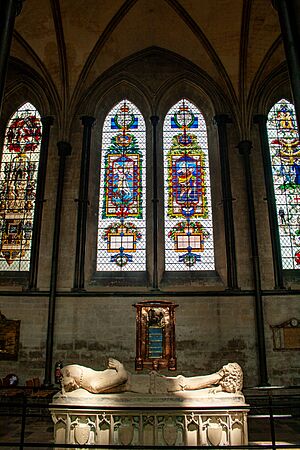John Montagu, 3rd Earl of Salisbury facts for kids
John Montagu, 3rd Earl of Salisbury, was an important English nobleman who lived a long time ago, from about 1350 to 1400. He held the titles of Earl of Salisbury and Baron Montagu. He was also a Knight of the Garter, which was a very special honor. John Montagu was known for being one of the few nobles who stayed loyal to King Richard II, even after Henry IV took the throne.
Early Life and Adventures
John Montagu was the son of Sir John de Montagu and Margaret de Monthermer. His uncle was William Montagu, who was the 2nd Earl of Salisbury before him.
As a young man, John Montagu was a brave soldier. He fought in the Hundred Years' War, which was a long conflict between England and France. He also traveled to Prussia to fight in another war. He likely joined an expedition led by Henry Bolingbroke, who later became King Henry IV.
Interestingly, Henry Bolingbroke trusted the Montagu family a lot. After his wife died, he asked them to care for his young son, who would later become the famous King Henry V. John Montagu's wife, Maud, looked after the boy at their family home in Welsh Bicknor.
A King's Friend
In 1391, John Montagu was called to join the English Parliament as Baron Montagu. He became a close friend and favorite of King Richard II. He traveled with the King on trips to Ireland in 1394 and 1395.
As a trusted advisor, he strongly supported the King's marriage to Isabella of Valois, a French princess. During trips to France for the marriage, he met and encouraged a famous writer named Christine de Pisan. Her son even received his education in the Montagu household.
John Montagu was also known for his religious beliefs. He was a Lollard, which was a group of people who wanted to change some things about the church at that time. The King even spoke to him about his views.
In 1397, John Montagu became the Earl of Salisbury after his uncle passed away. This meant he inherited important lands and properties. He continued to be a strong supporter of King Richard II. He helped the King deal with powerful nobles like the Duke of Gloucester and the Earl of Warwick. He even convinced the King to spare the Earl of Warwick's life. For his loyalty, he received some of Warwick's lands and was made a Knight of the Garter in 1399.
Final Years and Downfall
In early 1399, John Montagu went to France on a mission for King Richard II. He successfully stopped a planned marriage between Henry Bolingbroke and a French princess. Later that year, he joined King Richard II on another trip to Ireland.
However, while they were away, Henry Bolingbroke returned to England. When news reached them, Montagu was sent to Wales to gather an army to fight Bolingbroke. But the soldiers deserted, meaning they left their posts. Montagu then advised King Richard to flee to Bordeaux.
Instead, King Richard was captured and imprisoned. Henry Bolingbroke took the throne and became King Henry IV. In October, John Montagu was arrested along with many of King Richard's former advisors. He was held in the Tower of London.
Family Life
John Montagu married a woman named Maud Fraunceys. Her father, Sir Adam Fraunceys, was a very rich and powerful man in London. He was even the Lord Mayor of London twice.
John and Maud had three sons and three daughters:
- Thomas Montagu: He became the 4th Earl of Salisbury after his father. His daughter, Alice, became a very important noblewoman. Her grandson was Richard Neville, 16th Earl of Warwick, who was known as "Warwick the King-Maker." Alice's great-granddaughter was Catherine Parr, who became the sixth wife of King Henry VIII.
- Robert Montagu
- Richard Montagu
- Anne Montagu: She married Sir Richard Hankford. Their family line includes Anne Boleyn, who was one of King Henry VIII's wives.
- Margaret Montagu
- Elizabeth Montagu
Tragic End
After his release from the Tower of London, John Montagu joined a group of nobles in a plot called the Epiphany Rising. Their plan was to kill King Henry IV and bring King Richard II back to the throne.
However, the plot failed. John Montagu was caught by an angry crowd of townspeople in Cirencester. He was executed by beheading on January 7, 1400.
Even though his father was executed, John Montagu's eldest son, Thomas, eventually got back the title of Earl. The official record of John Montagu's guilt was not removed until King Edward IV became king in 1461.


